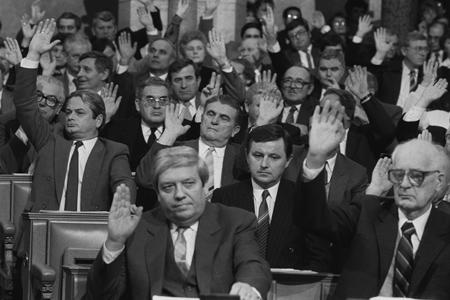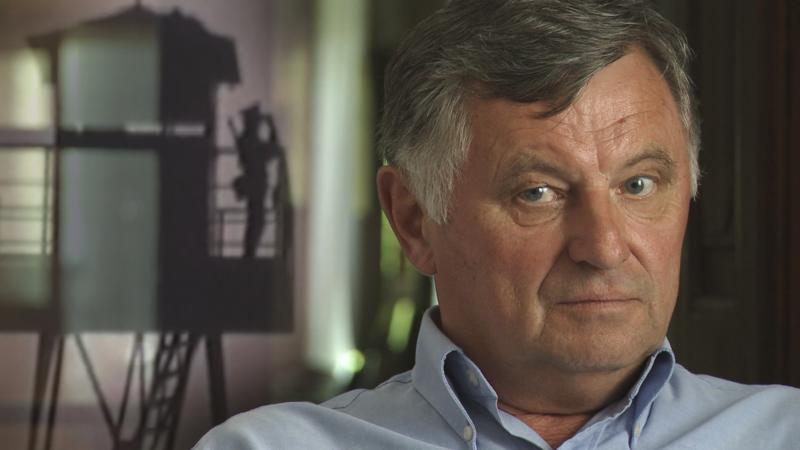"Mr Gorbachev, tear down that wall!" And Gorbachev did. The two Germanys were reunited and a divided Europe was made whole. The Cold War was over. As if by magic.
At least, that's how it might look now, 25 years later, when the fall of the Berlin Wall has long since slipped into the mythology of world history.
But the Danish director Anders Østergaard stumbled on an unlikely hero when he started looking for the right angle to tell the story of the most important European event of his generation.
Miklós Németh's Decision
How many people today remember the inexperienced Hungarian prime minister Miklós Németh who defied the Eastern Bloc hardliners Erich Honecker and Nicolae Ceaucescu and single-handedly decided to open Hungary's borders to the West, triggering a flood of events that proved unstoppable?
Németh, an unassuming economist and technocrat, saw that Hungary, like the rest of the Eastern Bloc, was bankrupt. The massive border controls to the West cost a fortune. So Németh decided to lift them. East Germans streamed into Hungary on their way to freedom. The whole system collapsed.
How did Németh dare make his epoch-making decision? According to "1989," his decision largely hinged on a young German married couple. Their fate moved Németh to be bold where others hesitated.
"It was the miracle of my generation," Østergaard says. Watching the funeral of Vaclav Havel reminded him of the significance of the events back then.
The Power of Circumstance
"I recalled the optimism right after the Wall came down and I felt like marking its 25th anniversary. Of course, I wanted to bring something new to the table and started thinking about the power of circumstance," Østergaard says.
"Some time passed before my Hungarian co-director Erzsébet Rácz and I realised that the killing of a German refugee by a Hungarian border guard concretely caused Németh to make his historic decision. He simply suffered a kind of personal moral breakdown that compelled him to act the way he did.
"There were other reasons why the Wall fell, of course, but that was a catalyst – and it's a great a story. I had found a key," Østergaard says about his conclusions after meeting with Németh.
Great events of world history can be triggered by small, personal stories and courageous actions by individuals. That's not news to Østergaard who is known the world over for "Burma VJ – Reporting from a Closed Country," his film about the Burmese video activists and their dogged, death-defying fight for freedom in Myanmar.
Most people today see the story of the fall of the Berlin Wall as something that was bound to happen. The wheels of history had shifted into gear. But it wasn't like that. A lot of things could have happened and turned out differently. It was imperative for Østergaard to show young people today that the outcome was far from a given and how much was up in the air and depended on the resolve of a few determined individuals.
Gorbachev was like a benign but enigmatic sphinx who tacitly and in cryptic terms accepted great changes but was not in a position to actively support them. If he had said, "Please help me phase out world communism," he would have been out of there, Østergaard says. It was up to others to decode how far they dared to go. The unnoticed, inexperienced Hungarian prime minister and party leader Miklós Németh went farther than anyone.
To Show How Uplifting 1989 Actually Was
"This thing about the little bookkeeper is so funny," Østergaard laughs. "That's how he sees himself, too: 'I was just a little economist.' The events back then are popularly viewed as a heroic outcome of the will of the people, but it was certainly also a matter of internal showdowns in the local communist parties in the Eastern Bloc."
When Østergaard and Rácz started thinking about the project, it seemed like a no-brainer to mark the year 1989 as the start of a new, peaceful Europe united by the dream of freedom and prosperity. But cold winds have been blowing out of the East lately. Political crises have been escalating in Eastern Europe, where Putin's Russia, in Ukraine and elsewhere, has acted in ways that are rousing ominous old ghosts.
"I wouldn't say that has influenced the process, but I think it's an interesting coincidence. The emergence of the Ukraine crisis casts the whole story and Europe's relationship to Russia in a different light and brings a whole new immediacy to it. Still, my incentive was NOT to depict the broken hopes and the problems, but try to show what was going on and how uplifting the events actually were when they happened."
At the time, Europe was divided by an Iron Curtain and no one imagined that it would ever be any different. That's just the way things were. One Europe on one side of the Iron Curtain and a very different Europe on the other side. For young Westerners like Østergaard, Eastern Europe was a shadow world, where people lived completely different lives under completely different conditions. Until suddenly, in 1989, that was no longer the case.
Talking Heads
A trained journalist, Anders Østergaard has made it a trademark to devise journalistic documentaries as formal experiments that take things much further than run-of-the-mill reenactments. "1989" includes footage of Honecker saying things in closed meetings that he would never have said if there was a camera in the room.
Like he did in his documentary portrait of Tintin-creator Hergé, "Tintin and I" (2004), Østergaard uses archival footage to flesh out his characters in a rather freely interpretive manner.
"We reconstructed dialogue based on research and put the words in the characters' mouths to recreate a situation. That's the trick. It's Gorbachev, only he's saying something different than he actually did that day. In that way, we get around the awkwardness of using actors in reenactments, which always breaks the illusion. Even Oliver Stone, with his huge budgets and the greatest acting talent in the world, struggles with credibility when he uses actors to represent historical figures," Østergaard says about his method, which can be described as a kind of mental green screen.
A controversial method, it promotes authenticity and catches the audience off guard, because part of us knows what we're seeing and hearing can't be true. They didn't try to make it perfect. It only has to look 90 percent right. People should be able to see that the film is playing with the material, Østergaard says.
"I don't think the audience will complain. Some historians and professionals might say it's bad journalism. But my answer to that is, It's NOT journalism! It's another way of telling a real-life story.
"I think it gives it edge," Østergaard says about his method. We agree.
"1989" celebrated its world premiere at CPH:DOX on 5 November as a true pan-Eruopean event, as the film was transmitted simultaneously to Danish cinemas and more than 20 venues across Europe.
"1989" is directed by Anders Østergaard and co-directed by Erzsébet Rácz and produced by Lise Lise Lense-Møller for Magic Hour with support from the Danish Film Institute.


